IT’S A HOTLY DEBATED TOPIC: what really makes a 4-season RV? We’ve heard from both sides of the aisle—RVers want greater durability to handle harsh weather, but they also want models that stay affordable and accessible. Let’s dive into some of the realities of cold-weather camping and explore the construction standards that make good, better, and best for year-round camping.
Key Takeaways
- Not everyone needs a true 4-season RV, but full-timers and year-round campers benefit from construction that handles both extreme cold and heat.
- Four-season capability varies by build quality, with key features including heated underbellies, composite insulation, ducted heating, dual-pane windows, and protected plumbing.
- R-values don’t tell the whole story—real performance depends on how insulation, airflow, materials, and components work together across the entire RV.
Table of Contents
ToggleWho Really Needs a Four-Season RV?
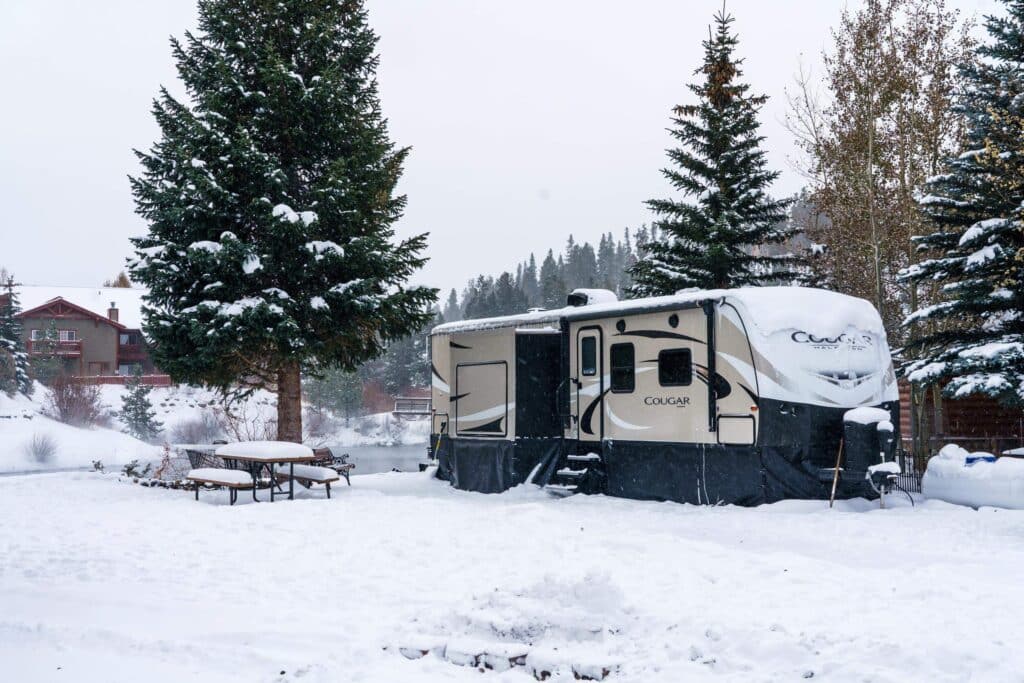
I’ll go out on a limb and say that most RVers don’t truly need four-season capability. On the same token, it shouldn’t be hard to find a 4-season RV if you want one. Realistically, most RV owners don’t use their camper during the coldest months of the year.
According to a 2025 RVIA study, RV owners use their campers for an average of 30 days per year. And while that’s a surprising 50% increase from the same study’s 2021 findings, it still signals that most owners are using their RVs for a few weekends each year—and preferably during the warmer months.
Have plans for RVing in the winter?
That said, four-season capability isn’t just about staying warm. These RVs should also handle the extremes of a mid-summer heatwave. Our minds often think of cold-weather protection when we consider 4-season RVing, but many who require this type of camper will also need protection when temperatures soar into the triple digits.
So, the question remains: who really needs a 4-season camper?
In recent years, shifting housing market conditions have led more people to consider RVs as full-time living options. And if you plan to park an RV for permanent living pretty much anywhere north of the 38th parallel (with exceptions), you’ll likely need four-season construction for the winter months.
Additionally, there are those of us who love winter camping. From seeing natural landscapes blanketed with snow to enjoying winter recreation to staying in popular locations when they’re at their least crowded, there are many motivators. But I’m willing to bet no winter camper wants to freeze their you-know-whats off overnight doing it. Hence, the need for a four-season trailer or motorhome.
While there will always be exceptions, those who really need a cold-weather camping RV often include two main groups:
- Full-timers who can’t relocate easily, whether that’s to avoid excessive heat or subfreezing temperatures.
- Year-round camping enthusiasts (from the heat of summer to the winter chill) who want to explore safely and comfortably wherever they camp, while enjoying peace of mind that the elements do not endanger their critical RV systems.
If you fall into one of those two categories—or have another motivation—you need to have a good grasp of what determines four-season RV construction.
What Makes an RV 4-Season Capable?
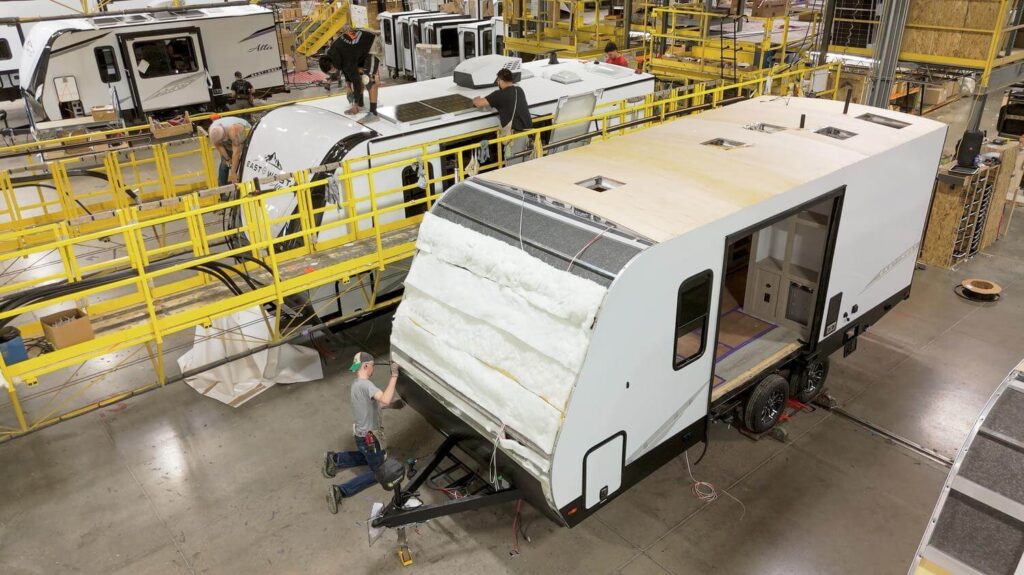
Talking about four-season capability in RVs always comes with a caveat—those seasons are way different if you’re talking about using your RV in Fargo, North Dakota versus Gulf Shores, Alabama. There are certainly some construction features that make some campers better suited for cold weather camping, but this caveat is one reason you’ll often see manufacturers label their models as “extended-season capable” versus calling them true 4-season RVs.
Still, what are those construction features if you’ve never researched year-round capable campers? Let’s break them down by good, better, and best—noting that there’s a lot of variation by manufacturer:
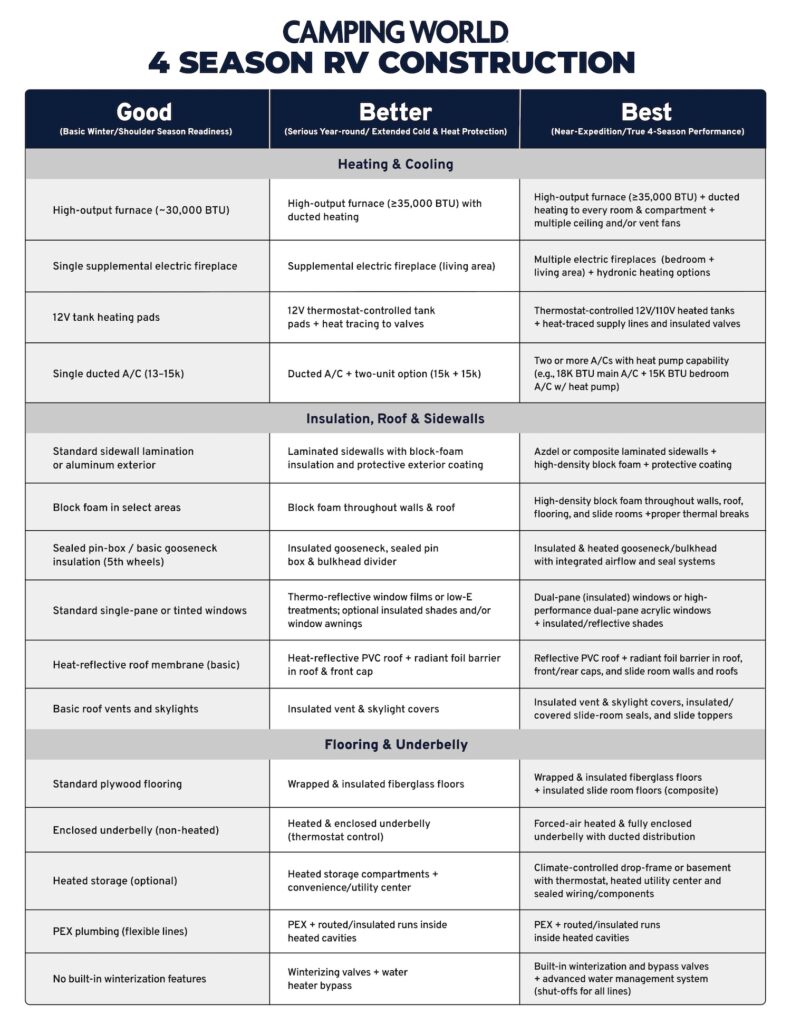
But how do these features translate into actual four-season capability?
The “Why” Behind these Construction Features
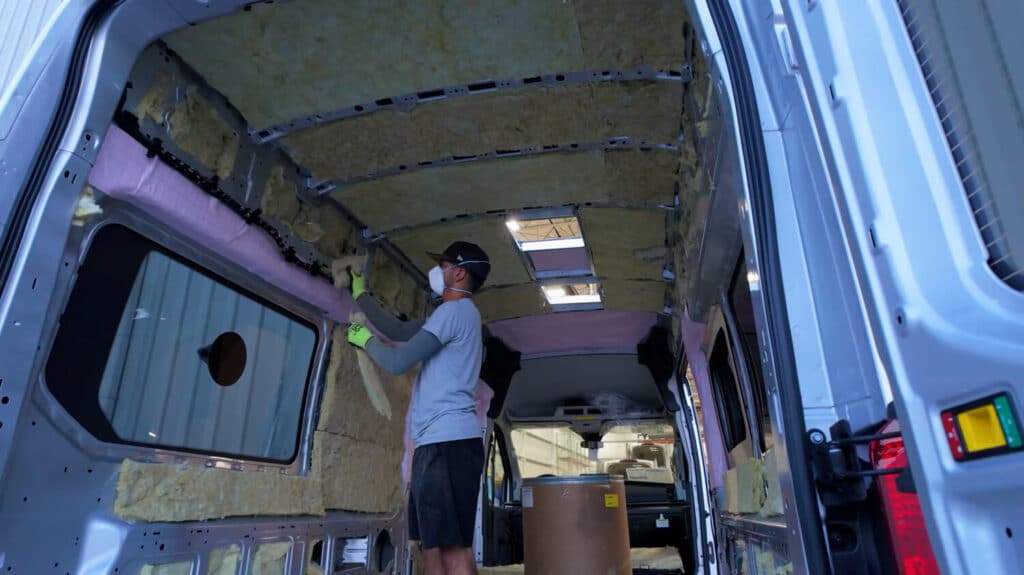
Across RV manufacturers, you’ll find various terminology to describe climate protection features—“four-season”, “Arctic Protection”, “Climate Shield”, “Polar Package”, etc. While it’s critical to understand the actual features listed for these packages, you should also understand why those features are important and how they provide advanced protection for an RV.
So, we’ve chosen these common weather protection features to illustrate the “why” behind them:
Heated & enclosed underbelly — The chassis cavity is sealed and warmed via furnace ducts or 12V/electric heating elements to protect tanks, valves, and plumbing from freezing.
Ducted heating to tanks and bays — Warm air is routed directly to holding tanks, valves, and plumbing runs, sometimes paired with tank pads or heat tape for freeze resistance.
PEX plumbing — Flexible cross-linked polyethylene tubing that tolerates minor freeze expansion and is typically routed through heated or insulated cavities.
Built-in winterizing valves & water heater bypass — Factory-installed valves that let owners bypass the water heater and pump antifreeze quickly and easily. Ideal for owners to winterize/dewinterize their RV multiple times during the colder months.
Azdel composite sidewalls — A non-wood, moisture-resistant composite panel used with block foam insulation for better thermal performance and reduced delamination risk.
Radiant foil or Astro-foil insulation — A properly installed reflective barrier installed in roofs, caps, and sometimes slide rooms to reduce radiant heat loss in winter and heat gain in summer.
Block foam insulation — Rigid, high-density foam cut to fit walls, floors, and roofs without sagging, often paired with foil or composite layers for higher R-values.
Dual-pane or insulated windows — Two-layer glass or acrylic with an insulating air gap to improve R-value, reduce drafts, limit condensation, and cut outside noise.
Supplemental electric heat — Electric fireplaces, heat strips, or dedicated heater circuits provide shore-power-based warmth, reducing furnace cycling and propane use.
Bedroom A/C with heat pump — A secondary air conditioner that can also heat electrically above ~35°F, reducing propane use and balancing climate control in multi-room layouts.
What About R-Values?
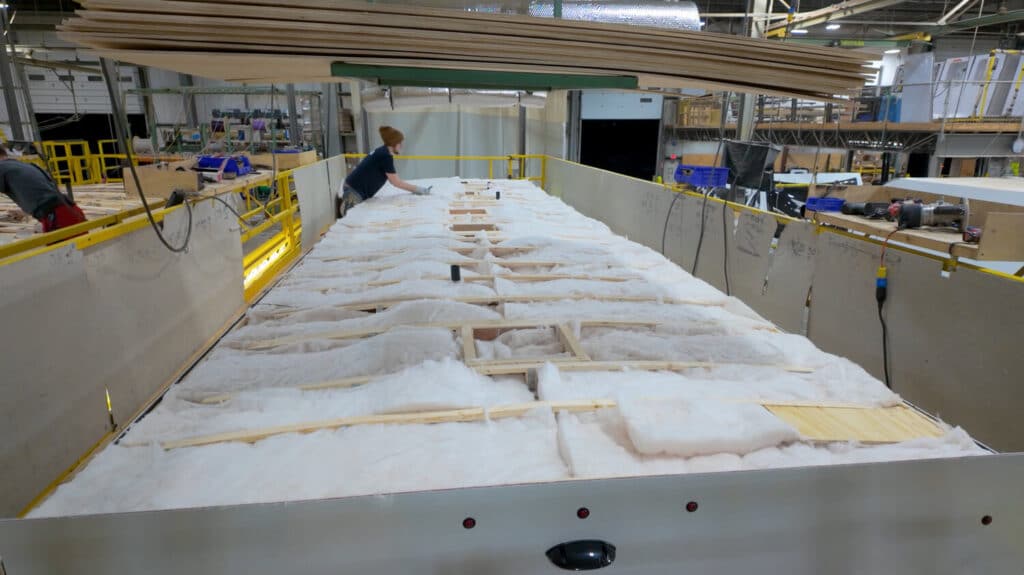
If you’ve done any research, you’ve likely noticed that some RV manufacturers are more hesitant to advertise R-values than others. To be honest, part of me gets it because R-values don’t always tell a complete story—I personally wouldn’t buy a four-season RV based on advertised R-values alone.
R-value is a rating system to rank the insulating properties of a material or collection of materials, as in the multiple layers often used to construct RV sidewalls. A higher R-value means better resistance to temperature conduction — AKA better insulation.
This is because not many manufacturers will confidently stand behind a singular R-value for their entire RV. They may claim that the sidewalls boast an R-7 rating, but this rarely accounts for the fact that several windows are cut into that sidewall, effectively lowering the value unless they are dual-pane or insulated windows with a comparable R-value themselves.
They may boast an R-18 rating for their RV’s ceiling, but that value may not hold true across the entire length of the camper, especially once you factor in skylights, roof vents, and other roof openings or mounted accessories. Unless those skylights are insulated and vent insulators are in place, the overall thermal performance can fall well below the advertised rating.
Where R-values can be handy, in my opinion, is when comparing straight across components..
For example, Grand Design’s Reflection 5th wheels claim to boast a double-insulated roof with an R-40 rating, compared to the Northwoods Arctic Fox Grande Ronde, which advertises an R-18 ceiling with R-15 reflective foil insulation. Even if you add these values together (which is only really effective if you’re sure there’s no air or air movement between insulation layers), the Reflection boasts a higher R-value for this specific construction component.
So, what’s the takeaway? These components (sidewalls, roof, floor, slide rooms, underbelly, etc.) don’t exist in a vacuum. Windows, roof vents, ducting, range hood vents, and other openings will all impact the true cold-weather capability of any RV.
What Do YOU Need in a 4-Season RV?
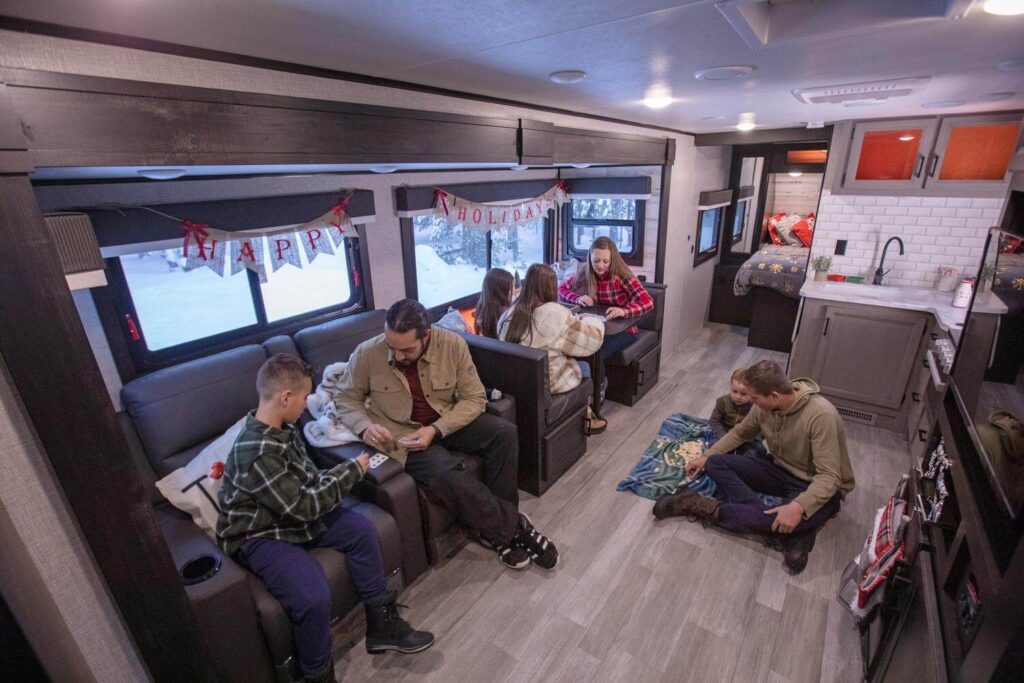
Now it’s time to sort through the complexity. Here are my top six features to look for when shopping for 4-season capable RVs:
- Enclosed underbelly with forced air heating to all compartments and areas with plumbing line runs, including the convenience center and battery compartment (especially if using lithium batteries).
- Composite sidewalls with block foam insulation and a radiant or reflective barrier.
- Composite slide room floors with reflective or radiant barrier insulation in the walls and roof, along with slide toppers to protect the roof and seals.
- Added fiberglass or block foam insulation with a reflective or radiant barrier in the front and rear caps.
- 12-volt heating pads and/or forced air heat to protect holding tanks, along with enclosed tank valves.
- Oversized furnace (35K BTUs or higher) with ducted heating to all rooms and at least one supplemental electric fireplace—one in the living room and a second in the bedroom is ideal.
Realistically, other features may have higher priority based on preference. For example, a full-timer likely won’t find as much value in built-in winterization valves as someone who takes their RV in and out of storage multiple times during the colder months.
Ultimately, water damage is arguably the greatest danger associated with winter camping—whether from frozen lines that crack and spring an unseen leak or from moisture intrusion resulting from compromised seams or seals. This is why our top feature is all about protecting plumbing from freezing temperatures, and the rest are dedicated to efficient heating and minimizing heat transfer with moisture-resistant materials.
Reality of Winter Camping in an RV
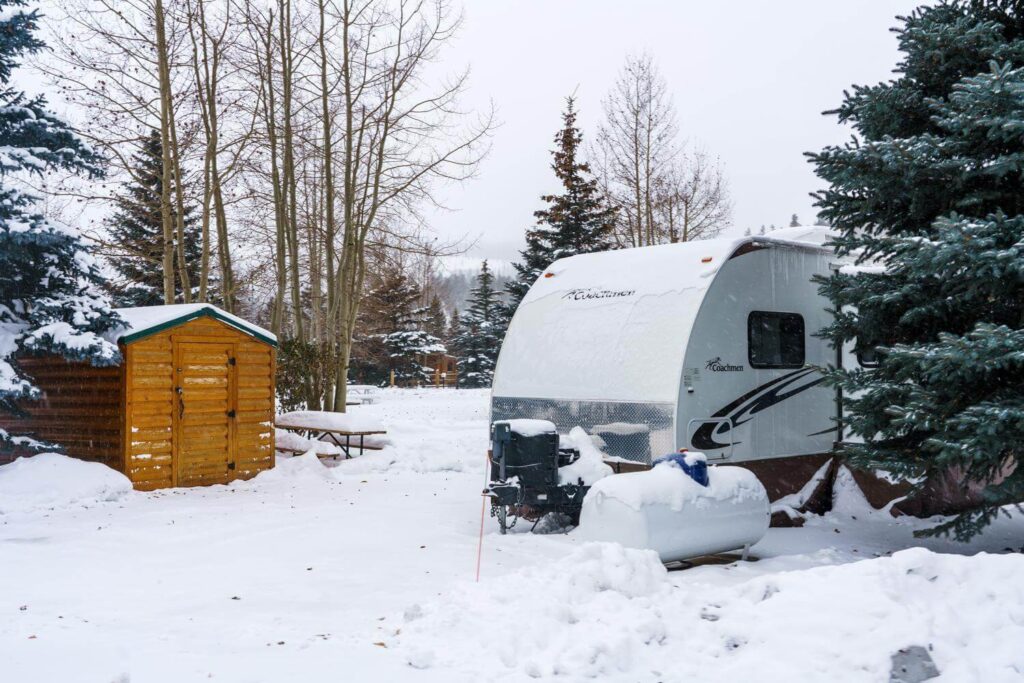
RV manufacturers are constantly leveraging new, scientific methods to get more out of the limitations that RVs present. However, RV walls, ceilings, and floors will only ever be so thick, making it nearly impossible to rival residential housing. Even the best summer or winter set up will fail if not used and maintained properly, and within the manufacturer’s stated limits.
From experience, the reality of braving subfreezing temperatures in any RV is that it’s likely going to require you to take additional precautions. For example, even the most robust camper construction doesn’t account for how you’ll safely connect to a city water connection without water in that hose freezing before it even gets to your RV’s plumbing.
Added steps to weatherproof your RV will likely include the use of a heated water hose, RV skirting, slide toppers, and more. That’s not to mention the importance of keeping the roof clear of snow if you get anything more than a light overnight dusting.
The truth is that there are plenty of “four-season capable” RVs out there these days. But that capability only goes so far. Ultimately, the RV owner who decides to spend the winter in North Dakota must do more to protect their camper from inclement weather and subfreezing temperatures than the owner who “snowbirds” down to warmer coastal air on the Gulf Coast.
Are You Ready for 4-Season RV Camping?
So where do you go from here? Hopefully, this puts some of the hotly debated aspects surrounding four-season campers into perspective, while highlighting the features that distinguish good from great when it comes to four-season RV construction.
- For RV owners, check out these winter RV camping tips to protect your camper from snow, ice, and freezing temperatures.
- For prospective owners, see which brands make a solid 4 season 5th wheel.
- Are you looking for a 4 season toy hauler?
- What Does It Take to Heat My RV?
And for everyone, let us know what you think about the 4 season RV debate and what truly makes a camper suited to extreme weather in the comments below!
Author
-

For nearly 60 years, Camping World has made RV ownership and the outdoor lifestyle safe, fun, and easy.
View all posts









Another hollow article on 4 season RVs. How can the author ignore fiberglass campers? I am confident my two piece shell Bigfoot with solid foam insulation throughout will out perform most if not all of the stick built campers in the coldest of conditions.
Thanks for reading and for bringing this up, Steve. You make a great point: two-piece fiberglass shell campers like Bigfoot and Northern Lite are absolutely known for exceptional cold-weather performance, and their molded construction with continuous insulation gives them advantages over many conventional builds.
This particular article focused on more widely available mass-market builds, which meant we leaned toward the types of things most shoppers will encounter on dealer lots. But you’re right that molded fiberglass campers deserve recognition in any discussion about four-season capability. We’ll look at adding a section or future content that highlights those options as well.
Appreciate you sharing your experience — it adds a lot for other readers researching 4-season RVs.
I sure hope the personnel working on the East To West RV under the title “What Makes an RN 4-Season Capable” are doing a better job than they did on mine. My East To West had had electrical not not hooked up and burnt wiring and AC ductwork not connected. Thankfully my local Camping World Service Center found the issues and fixed them no charge. After saying all of that, I am thinking of purchasing a 4-Season RV, but probably not a Forest River brand.